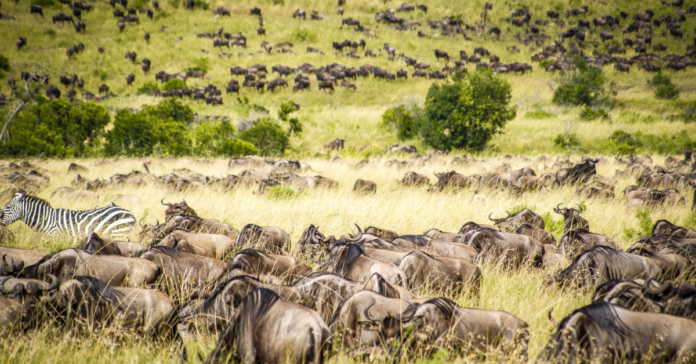
A deeper dive into the Audubon Society’s assertions last month that an amendment introduced by a Wyoming lawmaker would give oil and gas producers a “free pass to kill birds with impunity” does not reflect industry practices or federal and state regulations, nor does it rely on the best and most recently available data, according to a wildlife scientist and an environmental consultant.
Rep. Liz Cheney (R-Wyo.) introduced the amendment to the bipartisan SECURE Act that passed out of the House Natural Resources Committee in November. Cheney’s amendment clarified liability within the Migratory Bird Treaty Act (MBTA).
“This [MBTA] Act shall not be construed to prohibit any activity proscribed by section 2 of this Act that is accidental or incidental to the presence or operation of an otherwise lawful activity,” the amendment read.
Republican Reps. Steve Scalise (La.) and Bob Bishop (Utah), and Democratic Reps. Henry Cuellar (D-Texas) and Vicente González (D-Texas) jointly sponsored the bill.
The Audubon Society’s statement, quoted in the Casper Star-Tribune on November 12, accuses Cheney of giving oil and gas a “free pass” on killing birds, citing a 2006 study from the U.S. Fish and Wildlife Service’s Pepper Trail, “Avian Mortality at Oil Pits in the United States: A Review of the Problem and Efforts for Its Solution.” The study is the source for the statistic–500,000 to 1 million birds killed in oil waste pits—pushed by the Audubon Society and quoted by the Tribune.
A wildlife scientist challenged the study’s methodology, outdated data, and methods for calculating such avian mortality figures.
Rob Roy Ramey II, an independent scientist with Wildlife Science International, told Western Wire that Trail’s 2006 study, cited by the Audubon Society for the Tribune article, is not only based on overdone sample assumptions but also on outdated inferences about industry practices in the field.
“I think you can say with substantial certainty that Trail’s study is outdated and over-extrapolated. In other words, Trail’s study, as well as Ramirez’s (2010), were based upon simplistic extrapolations from non-random samples that were not systematically collected,” Ramey said.
“The industry has been moving away from pits for the last decade, in favor of more environmentally sensitive and cost effective technology. Eventually, these pits will be something of the past, as they should be,” Ramey said.
Tekla Taylor, President of Peakview Resources, an environmental consulting firm that conducts facility evaluations for regulatory compliance, agreed. She told Western Wire that Trail’s study was outdated and that the Audubon Society’s characterization of its conclusion was misleading and false.
“You’re not going to see open waste pits. They’re misrepresenting what they are,” Taylor said, referring to the Tribune article’s description of “oil waste pits.”
According to Taylor, contrary to what the Audubon Society is quoted as saying in the Tribune article—“industry can be careless, and there’s nothing anybody can do about it”—non-compliance will subject oil and gas producers to fines and even revocation of their permits. It’s hardly a regulatory regime without consequences, according to Taylor.
David Yarnold, President of the National Audubon Society, told the Tribune that Cheney’s amendment gave oil and gas “a free pass to kill birds with impunity.”
“No, that’s not true,” Taylor said. “You’ve got specific rules in place in Colorado and Wyoming,” Taylor said, that reference MBTA and include protections for public health and migratory birds alike.
The Audubon Society did not respond to an email for comment.
According to Ramey, the “rough calculation” derived from U.S. Fish and Wildlife statistics underlying Trail’s assumptions equates to a “reliance on authority” and “an obvious attempt to bolster credibility.”
“In truth, none of Trail’s ‘rough calculations’ or discussion of ‘broad patterns’ were based upon any systematic data collection or non-random sampling of locations, types of pits, or species,” said Ramey.
Ramey concludes that the estimates amounted to nothing more than “guesswork.”
“And finally, Trail did not acknowledge that other estimates of bird mortality (i.e., 2 million birds per year made by Ramirez (1999), or 1.5 million per year by Banks (1979)) were also based on extrapolations from unverifiable data and assumptions. The lack of systematic data collection and statistically valid estimates means that actual numbers of birds killed annually and the patterns of mortality from evaporation ponds are currently unknown. In effect, all of these estimates are equivalent to guesswork.”
Ramey cited a 2015 paper, “Direct Mortality of Birds from Anthropogenic Causes” in the Annual Review of Ecology, Evolution, and Systematics that concluded that a survey of relevant scientific studies of avian losses at oil and gas well sites “have not been studied sufficiently” or are “comparatively speculative.”
“Several other sources of direct anthropogenic bird mortality have not been studied sufficiently for systematic analyses to be conducted, including … entrapment in heater treaters and dehydrators at oil and natural gas well sites,” the authors wrote.
The paper was written by Scott Loss, Department of Natural Resource Ecology and Management at Oklahoma State University, Tom Will from the Division of Migratory Birds at the Midwest Regional Office of the USFWS, and Peter Marra of the Migratory Bird Center at the Smithsonian Conservation Biology Institute in Washington, D.C.
“Other mortality sources have comparatively speculative and/or very low estimates of mortality,” they wrote, including “drowning mortality at oil mining pits.” The authors asserted a lack of information in these areas did not preclude the possibility of mortality that was biologically significant, but could not draw any conclusions based on studies and data available.
Taylor has worked in states as diverse as Wyoming, North Dakota, Colorado, New Mexico, Texas, Louisiana, Ohio, Pennsylvania, Illinois, and West Virginia. She said referencing Trail’s study involves many assumptions that are no longer appropriate given changing industry standards, and lacked any systematic data for extrapolation nation-wide, echoing Ramey.
“The mortality rate of 500,000 to 1,000,000 bird deaths was in [Trail’s] words ‘clearly a rough estimation.’ The underlying assumptions did not involve any systematic approach and lacked appropriate field data,” Taylor said. “First of all, he assumed that every onshore oil well had one associated pit, which is a significant over-assumption, because we know that the standard industry practice is to temporarily store produced water and oil in closed tanks at oil and gas wells sites.”
“In an updated study by the FWS in 2013, they collected field data over a 3-year period to assess the success of regulations put in place to mitigate impacts to wildlife at oil and gas sites – looking at the same types of sites assessed previously by EPA.
They surveyed up to 505 suspect sites annually (so less than 10% of the sites were suspected to present a threat due to presence of some amount of oil) and recovered on average approximately 600 carcasses a year from 205 of those oil and gas facilities across 8 states,” Taylor said.
That 2013 FWS report from Pedro “Pete” Ramirez surveyed migratory bird mortality at oil and gas facilities across states in the West and adjacent plains.
“U.S. Fish and Wildlife Service (Service) law enforcement special agents and environmental contaminants specialists conducted inspections of oil and gas production facilities and commercial oilfield wastewater disposal facilities from 2007 through 2010 within Colorado, Kansas, Nebraska, Montana, North Dakota, South Dakota, Utah, and Wyoming to document risks and hazards to migratory birds,” Martinez wrote. “Service personnel recovered 1,405 bird carcasses from 205 oil and gas facilities during the three-year investigation (i.e. on average, 2.3 bird carcasses per facility per year).”
The Ramirez study noted that oil and gas operators took immediate action following the discovery of a number of bird carcasses in southwestern Wyoming, additional sites were inspected, 123 were closed, and “[s]ubsequently, oil operators retrofitted the openings of dehydrator tanks with netting or wire mesh to exclude birds.”
The paper also noted other regulations that have more recently come into place, such as the North Dakota Oil and Gas Division amending its oil and gas rules in April 2012 to prohibit the use of reserve pits for wells drilled below a depth of 5,000 ft (1,524 meters).
“The low numbers may be due to proactive measures facility operators are taking to prevent bird mortality at [centralized oilfield wastewater disposal facilities] and production skim pits such as netting small pits and keeping large evaporation ponds free of oil,” Ramirez wrote. These COWDFs formed the basis of Trail’s earlier estimates, drawn from Environmental Protection Agency and FWS data from 2002-2003.
These outdated data and inferences in Trail’s estimates don’t reflect current industry practices or state regulatory schemes, Taylor said.
“If you look at reserve pits, most of the state regulators (in the most actively drilled states) have put in place stringent rules requiring operators to mitigate impacts to migratory birds and wildlife at these facilities,” Taylor said.
“With respect to open dehydrator tanks and any other open tanks, subsequent to the study, states have adopted air emissions regulations that may require Best Available Control Technologies (BACT) be implemented to control emissions. Consequently, open tanks that exceed certain emissions limits must be covered. Smaller dehy tanks may not meet this requirement, but as the FWS indicated in their study, operators have been retro-fitting the tanks with wire mesh to prevent bird entry,” Taylor said.
“Primarily, they are required to keep any hydrocarbons out of the pit, as this is what attracts insects and birds. If the operators don’t comply with the rules they are subject to regulatory fines, penalties and potential revocation of their permit,” Taylor said.
“For example, Wyoming regulations require that if oil or other harmful substances are present in any pit, the oil or substance must be removed or the pit must be netted to prevent birds or other wildlife from entering. It should be noted that the FWS has recommended netting as a best practice. In Wyoming, reserve pits must also be fenced if there is oil or other harmful substances present,” Taylor said.
“In Colorado any accumulation of oil or condensate in a pit must be removed within 24 hours, unless the pit is specifically permitted for oil or condensate recovery. For those types of pits that contain hydrocarbons, fencing and netting are required. The regulator can also require netting if a potential risk is perceived. If an operator does not comply with the requirements, the regulator can revoke the pit permit and require closure,” Taylor said.
Facilities are permitted, Taylor said, and best management practices or regulatory requirements call for netting and other measures to protect migratory birds and wildlife, including retrofitting facilities and perimeter fencing. Sites are also inspected frequently, from twice weekly to every other day, Taylor said, as standard industry practice.
Cheney defended her amendment last month.
“My amendment clarifies congressional intent with respect to the migratory bird treaty act, the MBTA was enacted in 1918 to protect migratory bird populations from over-hunting, poaching, and illegal sales but ambiguous language within the MBTA has caused confusion to as to whether otherwise lawful activities are also prohibited simply because they potentially result in the unintended or incidental death of birds,” Cheney said in a November statement. “This ambiguous language has led to overzealous BLM guidance and regulations on energy operators in my state. It’s not just oil and gas, this is also hindering our wind turbine operators as well as home builders and coal mines.”
“The guidance now delays or restricts routine maintenance from occurring, can lead to completely unjustifiable delays or in permits being denied altogether. Our operators take multiple precautions to ensure migratory birds, as well as other wildlife, are not injured during operations but if these precautions fail, the current language could impose criminal liability for the taking of the bird even though it’s accidental,” Cheney said.
